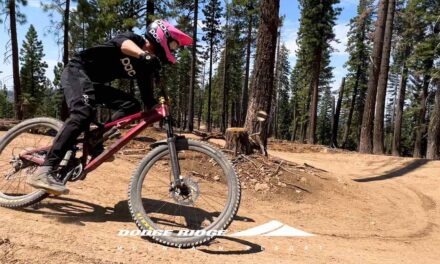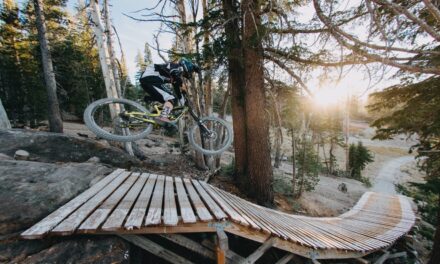- California Enduro Series Announces 2024 Schedule - 11/19/2023
- ASHLAND MOUNTAIN CHALLENGE 2023 – CES RACE REPORT - 10/04/2023
- China Peak Enduro 2023 – CES Race Report - 09/04/2023
MTB Rules for Rainy Season Riding
How to be a force for good when mountain biking after rain
Reprinted with permission from Hilltromper
The mountain bikers, they like the tacky. A little moisture on the trails makes for stickier, softer riding and fun times. But the rainy season can leave trails an ecological mess, with deep puddles flanked by improvised side trails, eroded routes and loose dirt cascading down steep hillsides. And that is so not hot.
We asked Drew Perkins, Trails Officer for Mountain Bikers of Santa Cruz and architect of the Emma McCrary Trail and Soquel Demonstration State Forest Flow Trail, for some best practices as well as things to avoid when hitting the trails around here in winter.
Hilltromper: How long after rain should mountain bikers wait to ride?
Drew Perkins: It depends on how much rain there was, how dry conditions were, and what the weather has been like. Early in the season (like our Halloween storm), the trails are like sponges and dry up relatively quickly. Later in the year or after a long wet spell, soils are pretty saturated, and it can take the trails a while to dry out. If it stays cool and damp, the trails dry out much slower than if it gets dry and windy.
Generally, I would say a very rough rule of thumb is 1 day per inch of rain is a good amount to wait after a big storm. A great place to check rainfall data is the website of the California Nevada River Forecast Center.
These guidelines are very general, and conditions vary greatly depending on geology (sandy vs. clayey soils and prevalence of seeps and springs), aspect (north-facing slopes like the Soquel Demonstration Forest take longer to dry out) and trail design (newer trails like Emma McCrary are designed to shed water frequently and minimize the amount of water that can accumulate on the trail).
The sandy soils of northern Fort Ord are a great place to go when conditions are very wet in Santa Cruz. Hilltromper’s note: the unofficial trails of Henry Cowell and Bear Mountain fall into that category as well.
These guidelines are also good for horses too! Horses can do a lot of damage to soft trails, but the condition of the tread is not so important to horse riders, so they might not even notice.
What are the three most important things riders can do (or not do) to make sure trails don’t erode or cause erosion on adjacent slopes?
I would say the most important thing is to avoid using the trails while it is raining or when it is so wet that water is running down the trail. When trails are soft from wet weather, the soil displaced by your tires/hooves is readily transported by raindrop splash erosion and water flow down the trail.
Second thing is to try and avoid skidding anytime you ride. Loose powdery dirt from skidding tires, even in dry weather, is easily washed away during rain events, and skidding potholes (breaking bumps) are common places for puddles to form. On steeper trails, if conditions are wet and the trail is slick and you are sliding the whole way down, same thing.
Third thing is it is probably better to ride slowly through a puddle than to ride around it and widen the trail.
Is there anything people should absolutely avoid?
If possible, avoid riding the trails while it is raining or right after larger storms where there is lots of standing/running water on the trails.
If you come across a really rutted or damaged trail, what should you do? Is there any mitigation you can do right there on the spot, or is there someone to contact about putting the trail in the pipeline for organized stewardship efforts?
I would say if you are finding lots of really wet rutted trail it would be best to modify your plans and head for a rocked road or other areas with better drainage. Small puddles in places where there is some side slope can often be drained with a scrape of your heel or a stick in just a short moment. MBoSC, Trailworkers.org, The Stewards of Soquel Forest and the relevant land managers are people you can contact with concerns. We are interested in finding more people who want to become trail stewards.
Speaking of organized stewardship efforts … what are they and what do we need to know about that?
Trailworkers.org hosts monthly trailwork at Wilder Ranch on the first Saturday of the month. MBoSC should be hosting several work days on the Emma McCrary Trail this winter, and MBoSC and The Stewards of Soquel Forest will be busy all winter out at SDSF maintaining the existing trails and building the rest of the flow trail.
Anything else you want to add?
Besides the condition of the trails, we should also think about the impacts that erosion on trails can have on aquatic habitat and water quality. Aquatic insects and fish don’t like to live in rivers and streams full of fine sediment that erosion from roads and trails can produce. I also hate working on my bike, so when it is really wet and I need to get out, I’ll do trail work, head down to Fort Ord, go for a hike or road ride instead of getting my mountain bike all dirty.
Learn more about Hilltromper—the nature-worshiping, fun-loving adventurer’s guide—here.













